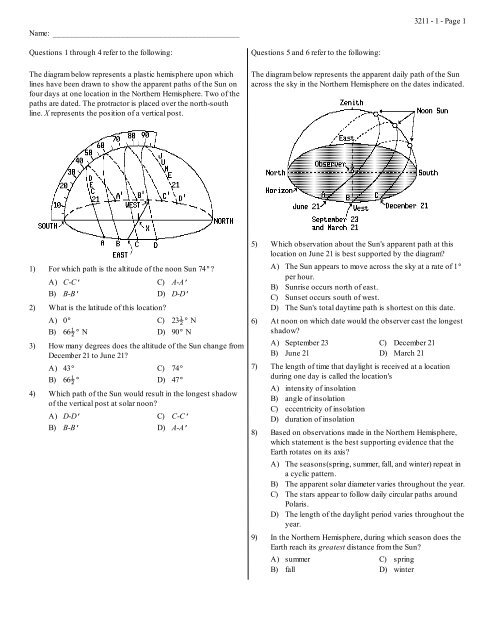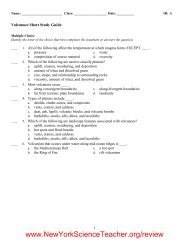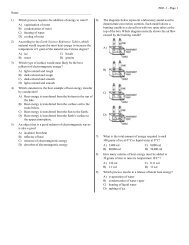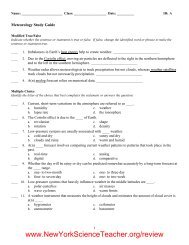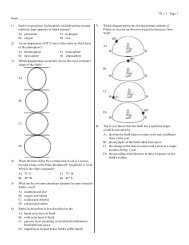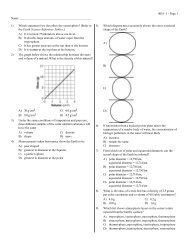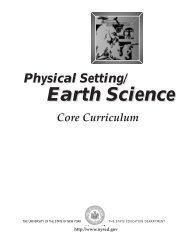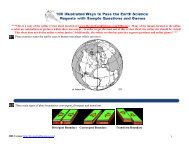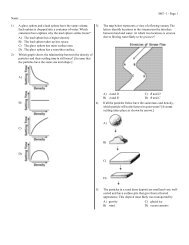Questions 1 through 4 refer to the following - Earth Science Review
Questions 1 through 4 refer to the following - Earth Science Review
Questions 1 through 4 refer to the following - Earth Science Review
Create successful ePaper yourself
Turn your PDF publications into a flip-book with our unique Google optimized e-Paper software.
Name: ____________________________________________<br />
<strong>Questions</strong> 1 <strong>through</strong> 4 <strong>refer</strong> <strong>to</strong> <strong>the</strong> <strong>following</strong>:<br />
The diagram below represents a plastic hemisphere upon which<br />
lines have been drawn <strong>to</strong> show <strong>the</strong> apparent paths of <strong>the</strong> Sun on<br />
four days at one location in <strong>the</strong> Nor<strong>the</strong>rn Hemisphere. Two of <strong>the</strong><br />
paths are dated. The protrac<strong>to</strong>r is placed over <strong>the</strong> north-south<br />
line. X represents <strong>the</strong> position of a vertical post.<br />
1) For which path is <strong>the</strong> altitude of <strong>the</strong> noon Sun 74D?<br />
A) C-C1<br />
C) A-A1<br />
B) B-B1<br />
D) D-D1<br />
2) What is <strong>the</strong> latitude of this location?<br />
A) 0D<br />
C) 23\D N<br />
B) 66\D N<br />
D) 90D N<br />
3) How many degrees does <strong>the</strong> altitude of <strong>the</strong> Sun change from<br />
December 21 <strong>to</strong> June 21?<br />
A) 43D<br />
C) 74D<br />
B) 66\D<br />
D) 47D<br />
4) Which path of <strong>the</strong> Sun would result in <strong>the</strong> longest shadow<br />
of <strong>the</strong> vertical post at solar noon?<br />
A) D-D1<br />
C) C-C1<br />
B) B-B1<br />
D) A-A1<br />
<strong>Questions</strong> 5 and 6 <strong>refer</strong> <strong>to</strong> <strong>the</strong> <strong>following</strong>:<br />
The diagram below represents <strong>the</strong> apparent daily path of <strong>the</strong> Sun<br />
across <strong>the</strong> sky in <strong>the</strong> Nor<strong>the</strong>rn Hemisphere on <strong>the</strong> dates indicated.<br />
5) Which observation about <strong>the</strong> Sun's apparent path at this<br />
location on June 21 is best supported by <strong>the</strong> diagram?<br />
A) The Sun appears <strong>to</strong> move across <strong>the</strong> sky at a rate of 1D<br />
per hour.<br />
B) Sunrise occurs north of east.<br />
C) Sunset occurs south of west.<br />
D) The Sun's <strong>to</strong>tal daytime path is shortest on this date.<br />
6) At noon on which date would <strong>the</strong> observer cast <strong>the</strong> longest<br />
shadow?<br />
A) September 23<br />
B) June 21<br />
C) December 21<br />
D) March 21<br />
7) The length of time that daylight is received at a location<br />
during one day is called <strong>the</strong> location's<br />
A) intensity of insolation<br />
B) angle of insolation<br />
C) eccentricity of insolation<br />
D) duration of insolation<br />
8) Based on observations made in <strong>the</strong> Nor<strong>the</strong>rn Hemisphere,<br />
which statement is <strong>the</strong> best supporting evidence that <strong>the</strong><br />
<strong>Earth</strong> rotates on its axis?<br />
A) The seasons(spring, summer, fall, and winter) repeat in<br />
a cyclic pattern.<br />
B) The apparent solar diameter varies <strong>through</strong>out <strong>the</strong> year.<br />
C) The stars appear <strong>to</strong> follow daily circular paths around<br />
Polaris.<br />
D) The length of <strong>the</strong> daylight period varies <strong>through</strong>out <strong>the</strong><br />
year.<br />
9) In <strong>the</strong> Nor<strong>the</strong>rn Hemisphere, during which season does <strong>the</strong><br />
<strong>Earth</strong> reach its greatest distance from <strong>the</strong> Sun?<br />
A) summer<br />
B) fall<br />
C) spring<br />
D) winter<br />
3211 - 1 - Page 1
10) On December 21, at which latitude would an observer find<br />
<strong>the</strong> Sun directly overhead?<br />
A) 23\D North<br />
C) 23\D South<br />
B) 90D South<br />
D) 0D<br />
11) How would a three-hour time exposure pho<strong>to</strong>graph of stars<br />
in <strong>the</strong> nor<strong>the</strong>rn sky appear if <strong>the</strong> <strong>Earth</strong> did not rotate?<br />
A)<br />
B)<br />
C)<br />
D)<br />
12) Which is <strong>the</strong> best indication that <strong>the</strong> Moon's distance from<br />
<strong>the</strong> <strong>Earth</strong> varies?<br />
A) <strong>the</strong> apparent change in <strong>the</strong> shape of <strong>the</strong> Moon<br />
B) <strong>the</strong> apparent change in <strong>the</strong> altitude of <strong>the</strong> Moon<br />
C) <strong>the</strong> apparent change in <strong>the</strong> diameter of <strong>the</strong> Moon<br />
D) <strong>the</strong> apparent change in <strong>the</strong> color of <strong>the</strong> Moon<br />
<strong>Questions</strong> 13 <strong>through</strong> 15 <strong>refer</strong> <strong>to</strong> <strong>the</strong> <strong>following</strong>:<br />
The diagram below represents a view of <strong>the</strong> <strong>Earth</strong> as seen from<br />
space. Locations A <strong>through</strong> H are on <strong>the</strong> <strong>Earth</strong>'s surface.<br />
13) The latitude of position G is 23\D South. During which<br />
months would <strong>the</strong> Sun's vertical ray be moving northward<br />
between locations G and E?<br />
A) July and August<br />
B) January and February<br />
C) April and May<br />
D) Oc<strong>to</strong>ber and November<br />
14) At which two locations could <strong>the</strong> Sun be directly overhead<br />
at local noon sometime during <strong>the</strong> same 24-hour period?<br />
A) B and C<br />
B) C and E<br />
C) D and F<br />
D) E and G<br />
15) When it is noon at location E, what time of day will it be at<br />
location D?<br />
A) afternoon<br />
B) morning<br />
C) noon<br />
D) night<br />
16) Which diagram below best represents <strong>the</strong> illumination of <strong>the</strong><br />
<strong>Earth</strong> on <strong>the</strong> first day of summer in <strong>the</strong> Nor<strong>the</strong>rn<br />
Hemisphere?<br />
A)<br />
B)<br />
C)<br />
D)<br />
3211 - 1 - Page 2<br />
17) Which statement best explains <strong>the</strong> apparent daily motion of<br />
<strong>the</strong> Sun?<br />
A) The <strong>Earth</strong>'s orbit is an ellipse.<br />
B) The <strong>Earth</strong> rotates on its axis.<br />
C) The <strong>Earth</strong>'s shape is an oblate spheroid.<br />
D) The <strong>Earth</strong> is closest <strong>to</strong> <strong>the</strong> Sun in winter.
18) In <strong>the</strong> diagram below, <strong>the</strong> direct rays of <strong>the</strong> Sun are striking<br />
<strong>the</strong> <strong>Earth</strong>'s surface at 23\DN. What is <strong>the</strong> date shown in <strong>the</strong><br />
diagram?<br />
A) September 23<br />
B) December 21<br />
C) March 21<br />
D) June 21<br />
19) The diagram below shows <strong>the</strong> Sun's maximum altitude (C)<br />
relative <strong>to</strong> a vertical stick in New York State on June 21. In<br />
which direction from <strong>the</strong> base of <strong>the</strong> stick does shadow C1<br />
point?<br />
A) west<br />
B) south<br />
C) east<br />
D) north<br />
20) New York State has several more hours of daylight in<br />
summer than in winter. Which statement helps explain this<br />
observation?<br />
A) The speed of <strong>the</strong> <strong>Earth</strong> in its orbit changes.<br />
B) The distance between <strong>the</strong> <strong>Earth</strong> and <strong>the</strong> Sun varies.<br />
C) The <strong>Earth</strong> is tilted on its axis.<br />
D) The diameter of <strong>the</strong> Sun appears <strong>to</strong> change.<br />
3211 - 1 - Page 3<br />
21) On March 21, two observers, one at 45D north latitude and<br />
<strong>the</strong> o<strong>the</strong>r at 45D south latitude, watch <strong>the</strong> "rising" Sun. In<br />
which direction(s) must <strong>the</strong>y look?<br />
A) Both observers must look eastward.<br />
B) The observer at 45D N. must look westward while <strong>the</strong><br />
o<strong>the</strong>r must look eastward.<br />
C) Both observers must look westward.<br />
D) The observer at 45D S. must look westward while <strong>the</strong><br />
o<strong>the</strong>r must look eastward.<br />
22) Why do stars appear <strong>to</strong> move <strong>through</strong> <strong>the</strong> night sky at <strong>the</strong><br />
rate of 15 degrees per hour?<br />
A) The stars actually revolve around <strong>the</strong> <strong>Earth</strong> at a rate of<br />
15D per hour.<br />
B) The <strong>Earth</strong> actually moves around <strong>the</strong> Sun at a rate of<br />
15D per hour.<br />
C) The stars actually move around <strong>the</strong> center of <strong>the</strong> galaxy<br />
at a rate of 15D per hour.<br />
D) The <strong>Earth</strong> actually rotates at a rate of 15D per hour.<br />
23) The tilt of <strong>the</strong> <strong>Earth</strong> on its axis is a cause of <strong>the</strong> <strong>Earth</strong>'s<br />
A) 24-hour day<br />
B) changing length of day and night<br />
C) uniform daylight hours<br />
D) 365[-day year<br />
24) During a period of one year, what would be <strong>the</strong> greatest<br />
altitude of <strong>the</strong> Sun at <strong>the</strong> North Pole?<br />
A) 0D<br />
C) 90D<br />
B) 66\D<br />
D) 23\D<br />
25) Some constellations (star patterns) observed in <strong>the</strong> summer<br />
skies in New York State are different from those observed in<br />
<strong>the</strong> winter skies. The best explanation for this observation is<br />
that<br />
A) <strong>the</strong> <strong>Earth</strong> revolves around <strong>the</strong> Sun<br />
B) <strong>the</strong> <strong>Earth</strong> rotates on its axis<br />
C) constellations are moving away from <strong>the</strong> <strong>Earth</strong><br />
D) constellations revolve around <strong>the</strong> <strong>Earth</strong>
<strong>Questions</strong> 26 <strong>through</strong> 28 <strong>refer</strong> <strong>to</strong> <strong>the</strong> <strong>following</strong>:<br />
The diagrams below represent four locations on <strong>the</strong> <strong>Earth</strong>'s surface at <strong>the</strong> same time on March 21. Lines have been drawn <strong>to</strong> represent<br />
<strong>the</strong> apparent path of <strong>the</strong> sun across <strong>the</strong> sky. The present position of <strong>the</strong> Sun, <strong>the</strong> position of Polaris, and <strong>the</strong> zenith (Z) are shown for<br />
an observer at each location.<br />
26) The Sun's apparent path <strong>through</strong> <strong>the</strong> sky on this day is a<br />
direct result of <strong>the</strong><br />
A) Sun's revolution around <strong>the</strong> <strong>Earth</strong><br />
B) <strong>Earth</strong>'s revolution around <strong>the</strong> Sun<br />
C) Sun's rotation<br />
D) <strong>Earth</strong>'s rotation<br />
27) What time of <strong>the</strong> day is shown by <strong>the</strong> Sun's present<br />
position at location A?<br />
A) midnight<br />
B) afternoon<br />
C) morning<br />
D) noon<br />
3211 - 1 - Page 4<br />
28) To an observer at location A, <strong>the</strong> Sun will appear <strong>to</strong> move<br />
from<br />
A) east <strong>to</strong> west at 15D/hr<br />
B) east <strong>to</strong> west at 1D/hr<br />
C) west <strong>to</strong> east at 15D/hr<br />
D) west <strong>to</strong> east at 1D/hr
<strong>Questions</strong> 29 and 30 <strong>refer</strong> <strong>to</strong> <strong>the</strong> <strong>following</strong>:<br />
On <strong>the</strong> map below, points A <strong>through</strong> E are points on <strong>the</strong> <strong>Earth</strong>'s surface.<br />
29) The time at point C is closest <strong>to</strong><br />
A) 6 p.m.<br />
B) 6 a.m.<br />
C) 12 noon<br />
D) 12 midnight<br />
30) Which day of <strong>the</strong> year is represented by this diagram?<br />
A) March 21<br />
B) June 21<br />
C) December 21<br />
D) Oc<strong>to</strong>ber 21<br />
31) The diagram below represents four positions of <strong>the</strong> <strong>Earth</strong> as it revolves around <strong>the</strong> Sun. At which position is <strong>the</strong> <strong>Earth</strong> located on<br />
December 21?<br />
A) B B) A C) C D) D<br />
3211 - 1 - Page 5
<strong>Questions</strong> 32 <strong>through</strong> 34 <strong>refer</strong> <strong>to</strong> <strong>the</strong> <strong>following</strong>:<br />
The diagrams below represent plastic hemisphere models. Lines have been drawn <strong>to</strong> show <strong>the</strong> apparent path of <strong>the</strong> Sun across <strong>the</strong> sky<br />
on June 21 for observers at four different <strong>Earth</strong> locations. The zenith (Z) is <strong>the</strong> point in <strong>the</strong> sky directly over <strong>the</strong> observer.<br />
32) Which location will receive <strong>the</strong> greatest intensity of<br />
insolation at solar noon?<br />
A) Equa<strong>to</strong>r<br />
B) Tropic of Cancer<br />
C) central New York State<br />
D) Arctic Circle<br />
33) In three months, <strong>the</strong> length of a day in central New York<br />
State will be<br />
A) longer, because <strong>the</strong> Sun will rise and set far<strong>the</strong>r south<br />
B) longer, because <strong>the</strong> Sun will rise and set far<strong>the</strong>r north<br />
C) shorter, because <strong>the</strong> Sun will rise and set far<strong>the</strong>r north<br />
D) shorter, because <strong>the</strong> Sun will rise and set far<strong>the</strong>r south<br />
35) The diagram below shows several positions of <strong>the</strong> <strong>Earth</strong> as it moves around <strong>the</strong> Sun.<br />
34) At which location will <strong>the</strong> longest noontime shadow be<br />
observed?<br />
A) central New York State<br />
B) Tropic of Cancer<br />
C) Arctic Circle<br />
D) Equa<strong>to</strong>r<br />
Which position shows <strong>the</strong> <strong>Earth</strong> during summer in <strong>the</strong> Nor<strong>the</strong>rn Hemisphere?<br />
A) B B) D C) A D) C<br />
3211 - 1 - Page 6
<strong>Questions</strong> 36 and 37 <strong>refer</strong> <strong>to</strong> <strong>the</strong> <strong>following</strong>:<br />
The diagram below represents <strong>the</strong> <strong>Earth</strong> at a specific position in its orbit. Arrows indicate radiation from <strong>the</strong> Sun. Points A <strong>through</strong> D<br />
are locations on <strong>the</strong> <strong>Earth</strong>'s surface.<br />
36) Which diagram below best represents <strong>the</strong> path of <strong>the</strong> Sun<br />
on this date as seen by an observer at location C?<br />
A)<br />
B)<br />
C)<br />
D)<br />
3211 - 1 - Page 7<br />
37) Which location would have <strong>the</strong> greatest number of daylight<br />
hours when <strong>the</strong> <strong>Earth</strong> is in this position?<br />
A) C B) A C) B D) D
<strong>Questions</strong> 38 <strong>through</strong> 40 <strong>refer</strong> <strong>to</strong> <strong>the</strong> <strong>following</strong>:<br />
The diagram below shows four positions of <strong>the</strong> <strong>Earth</strong> in its orbit around <strong>the</strong> Sun. The diagram indicates relative positions of <strong>the</strong> <strong>Earth</strong><br />
<strong>to</strong> <strong>the</strong> Sun, but <strong>the</strong> diagram has not been drawn <strong>to</strong> scale.<br />
38) Which graph best represents <strong>the</strong> relationship between <strong>the</strong><br />
Sun's apparent diameter and <strong>the</strong> positions of <strong>the</strong> <strong>Earth</strong><br />
around <strong>the</strong> Sun from A and D?<br />
A)<br />
B)<br />
C)<br />
D)<br />
39) When <strong>the</strong> <strong>Earth</strong> is at position A, where will <strong>the</strong> Sun appear<br />
<strong>to</strong> rise anywhere in New York State?<br />
A) north of due east<br />
B) due east<br />
3211 - 1 - Page 8<br />
C) due west<br />
D) south of due east<br />
40) For an observer in New York State, which event will occur<br />
when <strong>the</strong> <strong>Earth</strong> is at position C?<br />
A) minimum apparent diameter of <strong>the</strong> Sun<br />
B) minimum duration of insolation<br />
C) maximum intensity of insolation<br />
D) maximum altitude of <strong>the</strong> Sun


